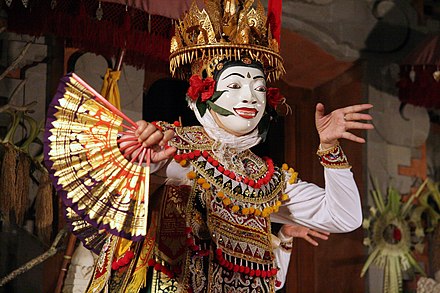Cakalele dance
 Cakalele dance performance | |
| Native name | Tari cakalele |
|---|---|
| Inventor | Eastern Indonesia |
| Origin | Indonesia |
| Cakalele dance |
|---|
|
| Burma |
| Cambodia |
| Indonesia |
|
| Laos |
| Malaysia |
| Philippines |
| Thailand |
|
| Vietnam |
Cakalele dance (pronounced "cha-ka-leh-leh", spelled tjakalele by the Dutch) is a war dance from North and Central Maluku in Indonesia.[1] Hybrid versions also exist among the natives of Sulawesi, Timor, and the Tanimbar Islands.[citation needed] The dance is performed by men, two of whom represent opposing captains or leaders while the others are the warriors supporting them. After an opening ritual, the captains engage in a mock-duel with a spear (sanokat) and long knife (lopu) while their supporters use a long knife in the right hand and a narrow wooden shield in the left hand.[2] The shield is referred to as a salawaku, or by a local name such as the Tobelo o dadatoko.[3] The cakalele originated as a way for the warriors to celebrate after a successful raid. Dancers dress in full warrior costume and are backed by the rhythm of the drum and gong (tifa) and fife (sulin).
Gallery
-
Cakalele dancers wearing traditional clothes
-
Cakalele dance performances in Maluku
-
Salawaku, the shield used in performances
-
Cakalele dance performances in the 1900s
-
Two cakalele dancers
-
Cakalele performance
See also
Notes
- ^ Qurtuby, Sumanto Al (2016-05-20). Religious Violence and Conciliation in Indonesia: Christians and Muslims in the Moluccas. Routledge. ISBN 9781317333289.
- ^ Albert G Van Zonneveld (2002). Traditional Weapons of the Indonesian Archipelago. Koninklyk Instituut Voor Taal Land. ISBN 90-5450-004-2.
- ^ P. E. De Josselin De Jong (1984). Unity in Diversity: Indonesia as a Field of Anthropological Study. Foris Publications. ISBN 90-6765-063-3.
External links
- Museum Maluku











